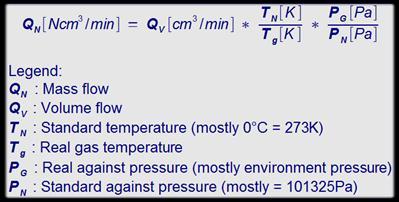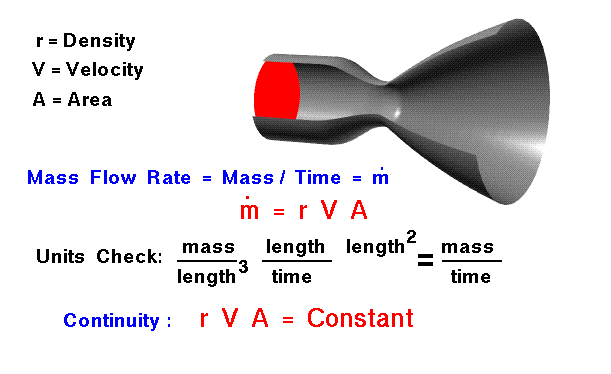What Is the Difference Between Mass Flow and Volumetric Flow
These are volumes per time not units of mass. ṁ ρ A v.
The volumetric flowmeter does not directly measure the volume but undergoes intermediate parameter conversion.

. Mass flow is measured in for example kilograms per second. Looking at the fundamental vacuum relationship QSP we have Gas Load Pumping Speed x Pressure or Mass Flow Volume Flow x Pressure. V velocity in ms.
The mass flow is best when accuracy is needed with a high-pressure rating. Commonly used units of mass flow rate are kilogramsecond or poundshour. Mass flow measurement would require additional sensors for these parameters and a flow computer to compensate for the variations in these process conditions.
Volumetric flow is best when measuring the volumetric flow of the gas and high accuracy isnt necessary. Units of mass flow. Mass flow measures just what it says the mass or weight of the gas flowing through the instrument.
For example the mass flow rate and volume flow rate of the gas. Indirect mass flow using a pressure transmitter and a temperature transmitter to determine the density of flowing fluid. In the formula qv is volume flow m3s.
172 views Promoted by Masterworks Whats a good investment for 2022. A areasection of pipe or a channel in m2. If the mass flow of the flow is known and needs to be converted into volume flow the following formula can be used.
Masters in Econ from Columbia FinTech at Masterworks Answered Jan 3 2022. This application note describes the difference between mass flow in terms of volumetric flow at standard conditions 101325 hPa 0 C and volumetric flow at nonstandard conditions. Because mass flow rate is a standardized volumetric flow rate the units are typically expressed as such.
There is also an added computation to convert the volumetric flow to mass flow. This can be explained as with higher temperature the gas expands. By referencing a volumetric flow cm 3min to its known temperature.
Mass flow measurement is then achieved by determining the variations in density with temperature and pressure. The cost between the two technologies is significant. Most commercial sales literature for pumps will provide a pumping speed vs.
The figure shows some examples. The volumetric flow measures the three-dimensional space occupied by the gas flowing through the instrument under the pressure and temperature conditions to be measured. There are some distinct advantages of using mass flow meters over volumetric meters.
Therefore a higher volumetric flow rate is required to pass the same number of molecules mass. Volume Flow Volume flow is most commonly used to describe and quantify pumping speeds. This method is called Indirect Mass flow measurement.
ρ is fluid Density kgm3. Qm is mass flow kgs. However when comparing results a volume flow meter requires additional temperature and pressure compensation.
Mass flow is a dynamic mass per time unit measured in grams per minute gmin. Volumetric measuring devices like variable area meters or turbine flow meters are unable to distinguish temperature or pressure changes. Put in simpler terms the mass flow rate is the WEIGHT of the sample while the volumetric flow rate is the SIZE of the sample.
Looking at the fundamental vacuum relationship QSP we have Gas Load Pumping Speed x Pressure or Mass Flow Volume Flow x Pressure. Mass flow or weight per unit time units are given in pounds per hour lbhour kilograms per sec kgsec etc. Mass Flow versus Volumetric Flow.
Mass flow can be represented by the following formula. When using volumetric meters there is the added expense of acquiring and installing additional equipment for temperature and pressure correction. Volumetric flow meters are recommended when measuring volumetric flow of the gas and when high accuracy is not needed.
Examples include SLPM standard liters per minute SCCM standard cubic centimeters per minute and SCFH standard cubic feet per hour. ρ density in kgm3. Qm Qvr Where r is the flowing density of the fluid.
As it is commonly known Mass flow measures the number of molecules in a flowing gas whereas volumetric flow measures the space that those molecules occupy. As gases are compressible and widely affected by temperature volumetric flow rates can significantly change depending on pressure andor temperature changes. Mass flow measurement would require additional sensors for these parameters and a flow computer to compensate for the variations in these process conditions.
Volumetric flow is measured in for example litres per second or cubic metres per second. So whats the difference. Compared to volumetric flow mass flow shows virtually zero fluctuation with pressure and temperature.
Massdensity x volumedensity x Area x velocity. When your specifications state units of flow to be in mass units there is no reason to reference. Volumetric measuring devices like variable area meters or turbine flow meters are unable to distinguish temperature or pressure changes.
Sierra Instruments new Minute Flow Tip video explains the differences between mass flow and volumetric flow measurement and why its important to industrial. Whereas mass flow meters measure flow rate independent of gas pressure and temperature. As it can be deduced from above a change of 25C in temperature will result in 735 cm3min volumetric flow difference in measurement while the mass flow would remain the same.
Volume Flow Volume flow is most commonly used to describe and quantify pumping speeds. Most commercial sales literature for pumps will provide a pumping speed vs. ṁ mass flow rate in kgs.

Density Mass Flow And Volumetric Flow Youtube

Mass Flow Rate Volume Flow Rate Velocity And Cross Sectional Area Youtube

Relationship Between Mass Flow And Volume Flow

Comparision Between Mass Flow Rate And Volume Flow Rate Thermodynamics Youtube

No comments for "What Is the Difference Between Mass Flow and Volumetric Flow"
Post a Comment